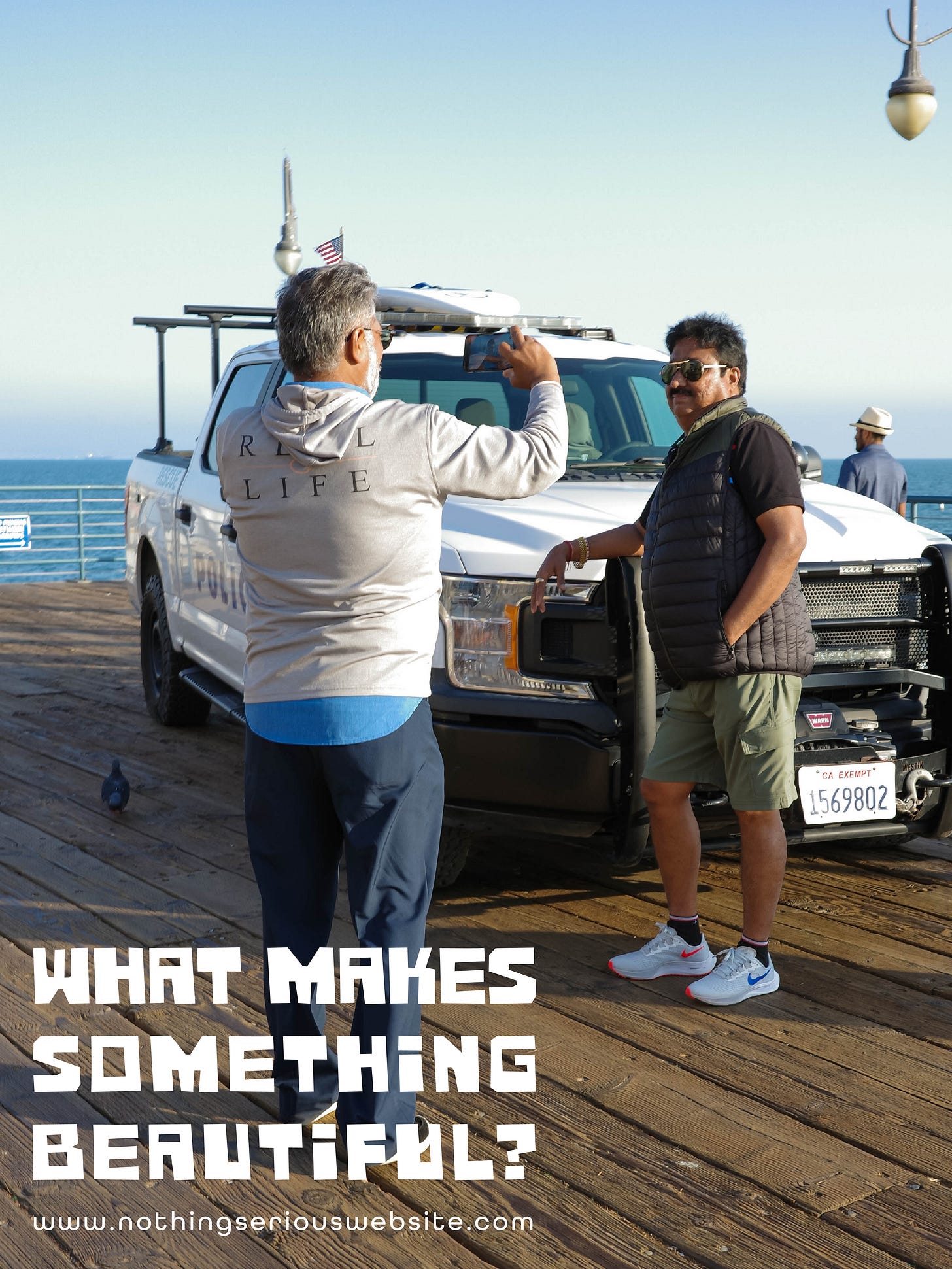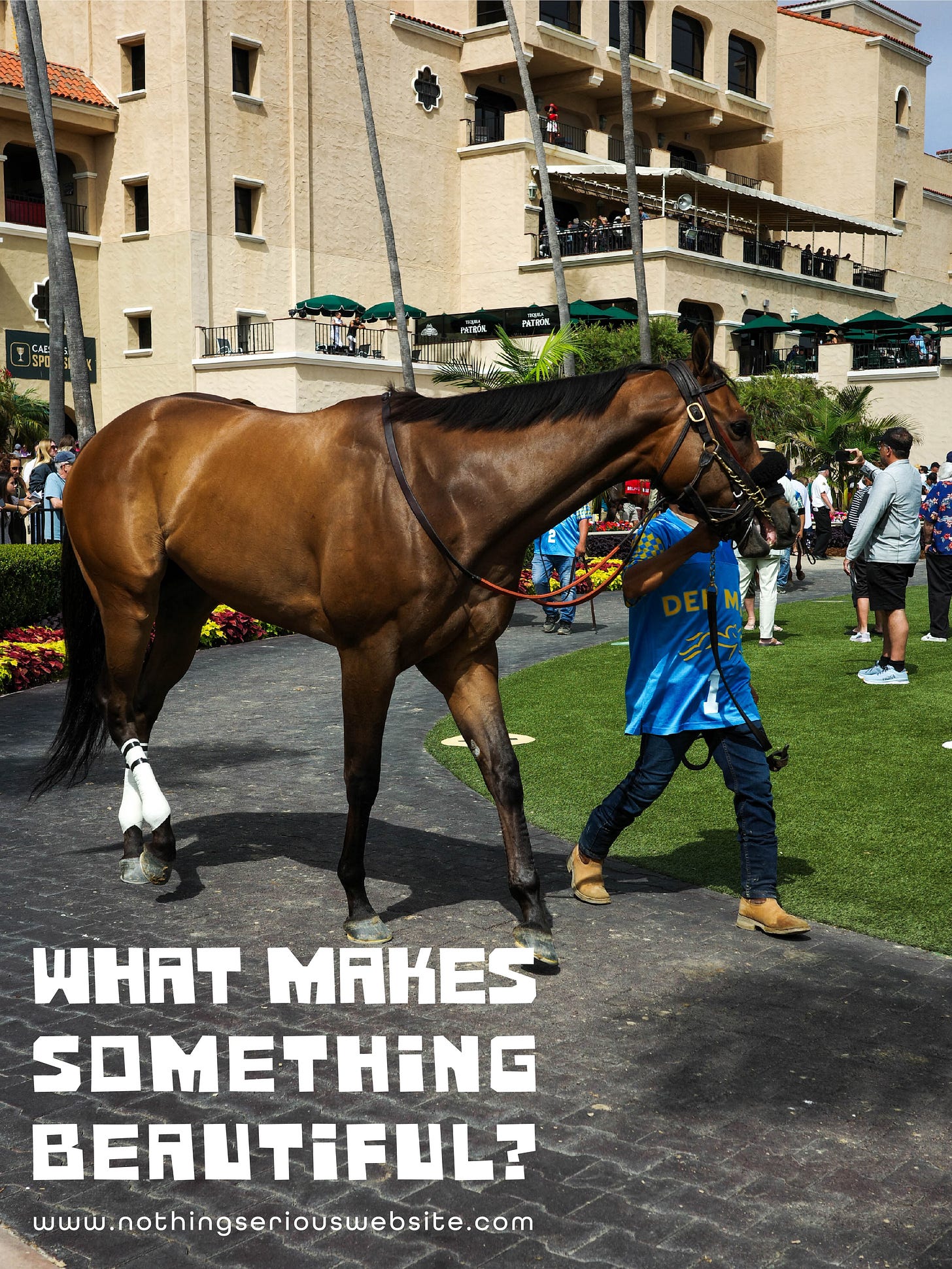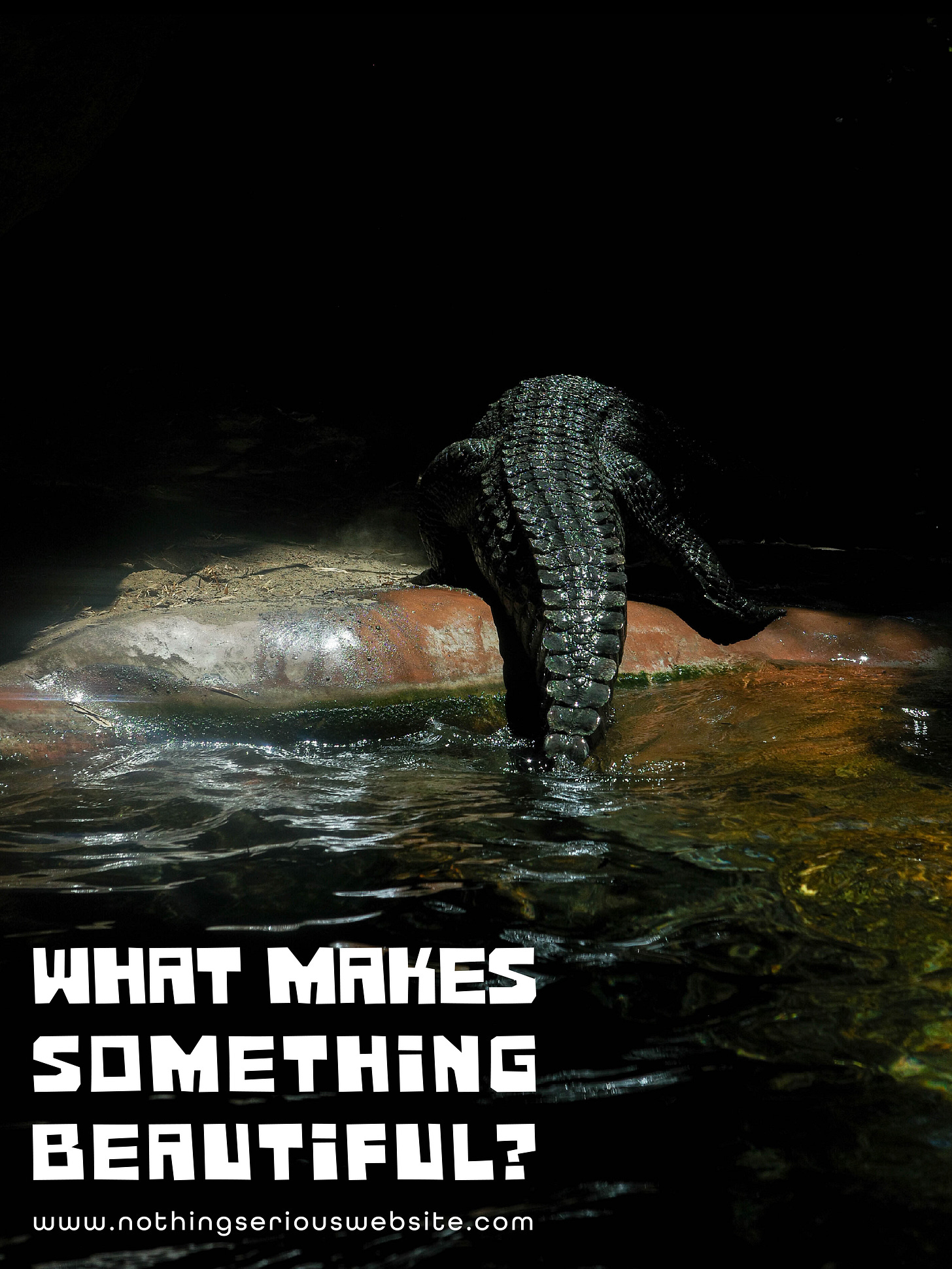Welcome Beings,
Below are the extracted words from the Nothing Serious Symposium, Dowse: The New Age Goldsmith.
Through a collaboration with the Being, Sean Dowse, an essence of his creativity was curated through the abstract question What Makes Something Beautiful? The words below were formed from the ideas explored.
Absorb the full symposium on the Nothing Serious Website HERE.
What Makes Something Beautiful?
I. Introduction to Beauty
The Italian painter, Elio Carletti, once described beauty as a summation of the parts working together in such a manner that nothing need be added, taken away, nor altered. And so begets a myriad of abstract questions in the realm of creating jewellery. Questions such as: How do we design beauty? How do we instil it within an object? How do we combine elements in such a precise fashion that we feel as though, as Carletti would argue, not an ounce of the final form need be eradicated.
These are inherently unknowable ideas which lie at the heart of all creative pursuits, especially those seeking some form of beauty. What makes something beautiful is an intangible concept that promotes a deep and endless dive into profound feuds over semantics, ideas, and impossible compromises concerned solely with uncovering some imaginary bridge between the subjective and objective experience. Which is, of course, the constant challenge within the world of art.
“If we understand what makes Beauty beautiful, then we can recognise Ugliness.”
— Tao Te Ching, Not-doing, Lao Tzu.
With this in mind, the intention of posing such a question here is not to fake some form of secret answer. But rather, through an in-depth discussion with Seán Dowse, a new age goldsmith and founder of the jewellery platform, Dowse, it simply became clear that the term beauty could perhaps embody an array of esoteric and emotional desires that exist within the soul of the artist as they engage in their specific craft, whatever it may be.
Such desires include an honouring of nature, an authentic expression of self, a pursuit of truth, a sharing of love, and a creation of something near permanent, awe-inspiring, and dare one say, important.
The Object Dude and his Silver Owls
II. Beauty as Importance
Is some form of reverence forever at the core of what we deem to be beautiful? Whether that be a widely accepted form of beauty — Nature, for example — Or whether that be within more personal forms, like the niche things we find beautiful in other people, or the areas of life we direct more of our energy toward because we believe they align closer with our innate way of being.
This is where the conversation with Dowse began. His self-adorned title of Object Dude, as well as an exploration into what may have shaped his specific creative interest: Jewellery.
As Dowse reflects, he notes that it must, like everything, come from his childhood. A time often spent fascinated by and consistently exposed to interesting objects, most notably the heavy, silver owls that lined the mantle piece of his grandparents’ fireplace.
“There was then a real sense of importance imparted onto those objects because of the way that they were displayed. I think I developed a relationship where I thought, ‘Okay, these are the things that are important because these are the things that are on display. These are worth something. And if I can make something that somebody displays in a glass cabinet, that's something of worth.’”
And maybe this is somewhat common. Not the specific details of Dowse’s experience. But the notion that certain reverences are passed down generations. The idea of a father playing music for his son and at a certain point saying to the boy “Close your eyes. Absorb this song. This is real music.” Or a mother taking her child with her to sell the art she’s crafted out of the boot of her car with the hopes of it brightening a person’s day, a stranger. “This is what it’s all about.”
“Find things beautiful as much as you can. Most people find too little beautiful.”
— Vincent Van Gogh, 1874.
It’s the power of art as a means to practice love. And it’s the child’s discovery of what it means to have something in your life that you believe to be more important than almost anything else. And it’s the question of how deep do these things go? How contagious are they? How complete and true do children absorb the perceived importances of their parents? And to what extent do they define the child’s way of existing in the world?
Perhaps the sunset is beautiful only after we learn of its importance, its meaning. Beneath the instant appreciation for its aesthetics there must be some unconscious reasoning within our minds working to feed us a reason as to why we should find certain things so beautiful. And could this permeate everything, from the friends we choose to the partners we chase? Our concept of beauty may be linked to that which we consider to be most important.
It’s the underlying presence of meaning. Cosmic dots connected to form core and unwavering opinions. A sense of self. A Being.
Jewellery and Jazz
III. Beauty in Craft
There’s that familiar sentiment: Beauty is in the eye of the beholder. But this idea marks only one side of the relationship: The audience, the receiver. Where is beauty for the creator? Should an artist aim to be the beholder of their own work? Is this even possible? And if so, at what point does the beauty of something manmade materialise? Well, undoubtedly the answer lies deep within a focus on process.
For Dowse, there is immense beauty in craft. The notion that there are no undo buttons when working with tangible three-dimensional elements instills something beautiful to the process. Although a comparison between jewellery making and jazz may not be entirely true, there are some interesting links as Dowse notes in his current way of working. Still developing his craft, trials and errors are part and parcel of the creative experience. And much like jazz, Dowse has developed a profoundly mature approach to his art by, as he notes, “Not being so tied to the end product.”
We all, on some level, seek this way of working. Even if our craft is based in more abstract work.
“Beauty in things exists merely in the mind that contemplates them.”
— David Hume, 1742.
We often want our art to be an exploration. But, that said, there is always a small inner-voice that always wonders if the easy way were possible, and if a straight forward step by step process could lead the artist to their imagined magical end product without stress, failure, or disappointment. But this is never the case. Nor do we truly want it to be. Because if it were so, we would lose that experience of suddenly stumbling across something unexpected and magic and perhaps even beautiful.
It raises the question, does beauty have to come from an attempt to control and shape the things we ultimately cannot? Is this how, as artists, we create something we ourselves find beautiful. When we know we were not in full control of the end product, but rather a channel for something bigger.
And it’s interesting to think in these esoteric ways in regards to jewellery. Often with painting and writing, there’s more freedom in process. But with jewellery, its a science based endeavour. Every tool existing for a specific job. One would think, therefore, that there would be no room for instinctual improvisation to take over. And yet, there is. With the beauty of the craft emanating from both a jeweller’s learning phase and their eventual mastery.
The Meeting of Magic and Science
IV. Beauty as Truth
Does beauty lie in the specific and infinite details of things? As Dowse notes, one thing he always returns to in his work is nature; the idea of present phenomenon beyond our control and comprehension that holds beautiful textures all around us. One need only take a closer look at the elements of the world to understand how everything in art is always a mere representation of reality. Begging another question along this path of constant asking: Did The Big Bang, or whatever the prime mover was, did it define the bounds of beauty? And is the artist’s motivation, their creative fuel, a desire to capture and reproduce a fragment of this beauty?
There is a meeting point between mathematics and emotion. We tend to separate one from the other believing that logic cannot apply to the messiness of human feeling. But our cosmos is governed by laws. Music uses math to make its effect. Jewellery uses physics to form its pieces.
“Beauty is truth, truth beauty, — that is all Ye know on earth, and all ye need to know.”
— John Keats, Ode on a Grecian Urn.
There is somewhat of an ugliness to the belief that we can tie everything to numbers. Love. Empathy. Spirituality. These always seem like concepts that should flow without rules. But we cannot deny the presence of these patterns. From the spiralled galaxies of our expanding universe to the double helixes of our genetic code. There are underlying connections in all the things we tend to note as being part of something beautiful.
Jewellery showcases this intersection of art and design, engineering and magic, in a more overt fashion than most other known mediums. The physics is at the forefront of the creative process. It dictates its direction. And yet, when we admire a piece of jewellery as non-jewellers, we never think of the science, we are simply struck by the feeling and meaning the art conjures inside of us.
The Paradox of Minimalist Jewellery
V. Beauty as Authenticity
Similar to art mediums like clothing and tattooing, jewellery awaits a final crowning before fitting into its full definition. It is art formed around the body. An ancient practice of decorating the living form. We travel back far into history and we see humans from all ages adorning themselves with silver and gold, leather and seashells. Granted, there were such practical reasons for this, one such being a convenient way to show and store one’s wealth. But beyond this, it becomes more evident how, as a meta-conscious species, we have always looked to instil profound meaning into inanimate objects. Even going so far as to transform ourselves into biological canvases.
“Wearing it.” Dowse answers with clear conviction when asked about where exists the line between object and jewellery. Though, of course, he acknowledges, one can get into semantics by travelling further down that kind of abstract road. But to him, this is the obvious definition, as it directly relates to his dominant purpose in making the stuff. The desire to create a comfortable and enduring piece of wearable artwork.
“Authenticity is where the art can come back into it.”
— Dowse, in conversation.
As Dowse himself notes, Jewellery is a pretty impractical thing. And not only that, it’s expensive. “It’s all a crazy fronting of costs.” But what it can do for a person that is undeniably practical, and perhaps even essential, is shift focus toward authenticity. Both in the creation of the piece, as Dowse customises his commissions to suit each individual who will wear them, and in the owner’s admiration of the piece.
In almost every creative practice money and access allow the art to exist on a grander stage. That said, however, money and access are not essential in the creation of beauty. It seems that all that’s ever really needed is a willingness to lay down an authentic effort.
Making Something You Really Love
VI. Beauty as Love
Of course, there’s no real way to define beauty. It’s always a thought exercise when it comes to topics such as this. But over the course of the conversation, Dowse illuminates an array of solid pillars that uphold our universal concept of what makes something beautiful. A human history of seeking some kind of truth, love, meaning, authenticity, and all without any promise of an absolute answer.
“It speaks to the nature of reality,” Dowse comments. We’re seeing and listening and using our senses to take in as much of the world as we can. But it's not an accurate portrayal, ever. What you're seeing is not the full representation. It's not the full texture or quality of everything that you're looking at. It's just not something you can perceive.
And this is where Dowse likes to live creatively; making things that don't make complete sense to him. Or at least going in with the intention to make something that doesn't immediately occur to him, puzzles him, and yet still somehow works.
One could argue, he searches to reproduce that experience of holding those heavy silver owls in his grandparents house and wondering, what is it about these that are worth displaying? And how can I create my own version of it?
And these are impossible questions to answer. But it’s the way of thinking about it that matters. It’s the want to look for the beautiful that is the key. And like true love, you just know it when you’ve found it. Some things are just beautiful because they are. There is no need to understand why. But there is a need to question why. As Dowse poetically puts it: “That is something that I pull from real life a lot. It's like, you can't understand real life, but you can still find it to be very beautiful, you know?”
“Love is the beauty of the soul.”
— St. Augustine.
And, as Dowse concludes, “It's inherent. It’s an immediate type of response that you're going to have, because some things are only beautiful once you realise the importance or significance of them, and then there's some things that you look at, and, it's beautiful. And there isn't a science really to that. But there is some kind of universal framework as to what makes things beautiful. And I'm sure if you take a sculpture degree, they'll probably try and explain it to you in that way. But you're not gonna get the full essence of it. Really, you just try and practice and refine your sense of composition, completion, and your sense of making something that you really like, and then the closer you get to really loving it yourself, that’s usually a very straightforward way to make something beautiful.”












